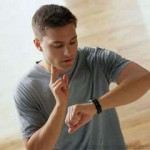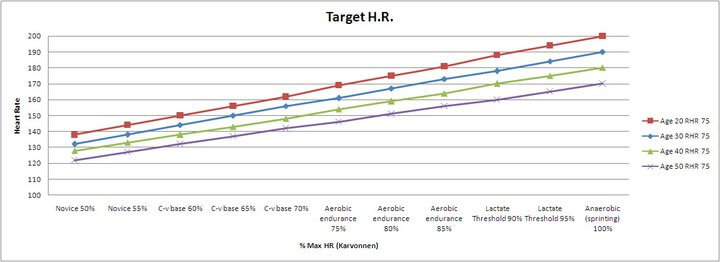Heart rate is the body’s tachometer. Heart rate is a very good reflection of how hard your body is working at the moment. It is like the tachometer in your car that measures engine RPM; the faster the engine spins, the faster the car goes in a given gear. If your heart is working harder, you are putting out more power, which translates to higher speeds, all other factors being equal. Conversely, riding at a fixed heart rate—say 140 beats per minute—in your large chain ring, you will go faster than in your small one, while using the same energy.
Certainly the best way to measure your heart rate is to purchase a heart rate monitor (HRM). These cost around 2,000 baht and upwards in Thailand. Wrist-watch styles can be used in multi-sport training, while cycling-specific models are more convenient for pure cyclists. There will be a chest strap that passively and painlessly senses your heart beat in the same way the ECG machine in your doctor’s office does. It sends the data to the wrist- or stem-mounted unit. Depending on the model, target training zones can be set and time spent within the zones can be recorded. The higher-end units can upload your data for more detailed analysis on your computer and for online comparison with other athletes.
It is totally possible to estimate your heart rate by simply taking your pulse however. Be SURE you can ride comfortably and stably one-handed before attempting this however! Practice on a stationary trainer and a closed course (an empty parking lot) before doing it on the road.

2. Place TWO fingers GENTLY on one of your carotid arteries. They are about 2 cm above and to the side of your larynx (Adam’s apple), just below your jaw.
3. Count the beats for 10 seconds and multiply by 6 to know your heart rate in beats per minute (BPM).
How fast can my HR be?
Endurance athletes plan their training in terms of heart rate zones. Each zone represents a specific kind of fitness training. They are based on percents of Maximum Heart Rate (MHR). Your maximum heart rate can be estimated by various formulas such as 208-(0.7 x age) (called the Tanaka method; http://content.onlinejacc.org/cgi/content/abstract/37/1/153), but it is best measured directly when you are riding as hard as you can, preferably into a stiff wind or up a steep, long hill in the highest gear you can turn over. Personally, I’ve found that the generalized formulas underestimate my actual MHR by 8 to 11 %. Do NOT attempt an MHR test if you are very unfit or sedentary or have any underlying cardiovascular disease. Extreme efforts can initiate a stroke or heart attack.
How fast SHOULD my HR be?
Knowing your MHR, you can then calculate training zones. Progress through these gradually over a year or so (if you’re a brand new endurance athlete) and you will find enormous health and vitality benefits, like weight loss, higher energy levels, better and more efficient sleep, stronger immunity and higher concentration at work.
1. Novice Zone is for riders who have done no exercise at all for a long time. Train at 50 to 60% of MHR until it is easy to reach 60% and hold it for an hour or so.
2. The cardiovascular Base Zone (60-70%) improves cardiovascular endurance–heart and breathing muscle strength and capacity that lets you keep going and going and going. It also teaches muscles to burn more fat than they normally do, which saves your quick energy sugar supply for the really tough climbs and sprints.
3. The Aerobic Endurance zone (70-85%) rapidly improves how your body burns fuel, and continues strengthening the heart. The fat:sugar burn ratio here is lower, but the total energy burned is much higher, so if you can keep it up, you will actually burn more fat in this zone than in the Base Zone. A 75 kg rider might burn 700-900 Kilocalories an hour here, of which a third or more might be fat calories. This is the zone in which most people would ride a ‘serious’ event like a race or century while going for a Personal Record.
4. The Lactate Threshold zone (85-95%) improves Muscular Endurance most rapidly. This is the BURN zone and it is hard work so only do it as intervals. From 3-30 minutes at a time, repeated 2-5 times per total workout. Rest periods between repeats must be only 1/2 of the work periods! Do this to improve your power up hill, and into head winds.
5. The Anaerobic zone (95-100%) is only for high-speed sprints at the end of races. Even world class sprinters can only stay in this zone about 1-2 minutes because the lactic acid forces the muscles to stop working. If you want huge, heavy muscles train here, but honestly, it is relatively useless for long-term health and life time fitness maintenance.
The Effect of Age
A much more sophisticated and accurate method is the one devised by Karvonnen. They consider the rider’s age and resting heart rate as well. The online calculator at http://www.racedaynutrition.com/HeartRate.aspx is a convenient way to work them out .
To understand the effect of age, take a look at the chart below. The Zones (on X-axis) are comparable with percent maximum power output. It’s clear that older people reach any given percent of their maximum at lower heart rates, which simply means that they will be going slower despite being closer to maxing themselves out. Younger people have higher overall power outputs than older ones—thank goodness for age-group races!

As a very rough example a 50 year old riding at 80% of his max has the same power as a 20 year old at just 60%. You can also say that the 50 year old is burning more energy–working harder– to get the same power as the 20-year old. (About a third more in fact; (80-60)/60). It is perfectly possible for older guys to outride younger friends however if the older one is well-trained. He will be capable of riding at a higher percent of his maximum and sustaining it longer. Better technique and nutritional knowledge comes into play as well. Sometimes experience does pay off.
If you have trained for a few months, your resting heart rate will decline. Then, your charted performance line will be steeper, although the maximum will remain the same (MHR is genetically determined). The result is that a 30-year-old might reach his FORMER 75% at just 140 BPM. With an MHR of 190, he would be at a Karvonnen percent of only about 64%, meaning his zone would be Cardiovascular Endurance, not Aerobic Endurance.
The skinny is that as you get better, you must train harder to keep getting better. This is not a problem for people with strong goals to enjoy life and avoid the worst morbidities of aging through the beautiful means of cycling. As we age, extending the race against mortality becomes more exciting than winning a race against other humans.
Leave a Reply